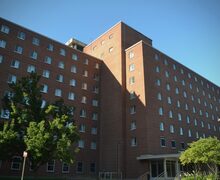Community gathers to honor AIDS victims
Carol Warren lights a blue candle in memory of AIDS victims.
‘The blue candle is a symbol of hope,’ said Warren, coordinator of the Syracuse Names Project. ‘It began in the 1950s when mothers of those affected by polio would light candles every night until a cure was found.’
As part of World AIDS Day, almost 200 Syracuse community members gathered at the 2008 Central New York AIDS Memorial Quilt Exhibition at the OnCenter in downtown Syracuse. The event commemorated AIDS victims in an effort to raise awareness and to inspire audience members to take part in the effort. The exhibition runs through Wednesday night.
The exhibition displayed 34 quilts produced by the Syracuse Names Project. The organization helped family members and friends create a 3-by-6-foot panel to represent their loved ones. Each quilt contained eight panels, representing 272 HIV/AIDS victims.
Victims’ names echoed in the convention center before the opening ceremony Monday night – those who died from HIV/AIDS in the Syracuse community were acknowledged by name.
After 45 minutes elapsed and all the names were read, Stephen Waldron, coordinator of the event, greeted the audience and discussed how this year’s event is different than in previous years.
‘This year, the theme is leadership, in which we keep the promise to find a cure,’ Waldron said. ‘Tonight is about academics. Faith leaders will join us tomorrow night and grassroots leaders on Wednesday.’
Syracuse University’s Chancellor Nancy Cantor delivered the Reflections on World AIDS Day speech. Cantor said HIV/AIDS is embedded in the inequalities of our society.
‘We need to understand AIDS in a social context,’ she said. ‘People don’t realize that the AIDS epidemic is largely affected by social issues, such as incarceration and homelessness. We need to eliminate the ethnic, race and gender discrepancies of those affected by the syndrome. Injustice is at the core of the AIDS epidemic.’
Cantor also discussed types of treatments and how quality care cannot be given with different eligibility requirements. Cantor and other speakers at the event said the new administration in Washington should consider starting a national AIDS strategy.
‘Just because we currently are in a bad state economically, that does not excuse putting AIDS on the back burner,’ Cantor said. ‘The social issues we face and HIV/AIDS are intertwined.’
Cynthia Morrow, health commissioner for Onondaga County, acknowledged the epidemic’s 27th year of existence and urged listeners to reconnect with the disease in order to spark change.
‘Twenty years ago, when I was in medical school, AIDS was relatively rare,’ Morrow said. ‘Now, 33.2 million people are affected, and yet, it is preventable.’
Approximately 175 Syracuse residents attended the event, which, to some, wasn’t enough.
Emily Allen, a junior English and textual studies and secondary education major, founded OrangeAid, SU’s new HIV/AIDS awareness student organization.
‘I was kind of disheartened at the fact that there were not more people,’ Allen said. ‘It just drove home the fact that people do not understand just how close this epidemic is to us, and that it affects our daily lives and the lives of those around us, whether we know it or not.’
Kathleen Hanna, a Syracuse resident, agreed with Allen.
‘It infuriates me that there weren’t more people present,’ Hanna said. ‘Tonight’s event reaffirmed the international and national tragedy that is taking place right in front of our eyes.’
Michael DeSalvo of the Friends of Dorothy House, an organization that offers health services to terminally ill patients, gave the closing remarks. He said that though there have been medical improvements, people are not doing their best to prevent the spread of HIV/AIDS.
‘Those who are tested positive for HIV/AIDS have the power to slow down the disease,’ DeSalvo said. ‘We have to help those that are most vulnerable to the disease. In the end, it is not how much we have loved, but it is how much we have hurt others. Get tested.’
Published on December 1, 2008 at 12:00 pm





